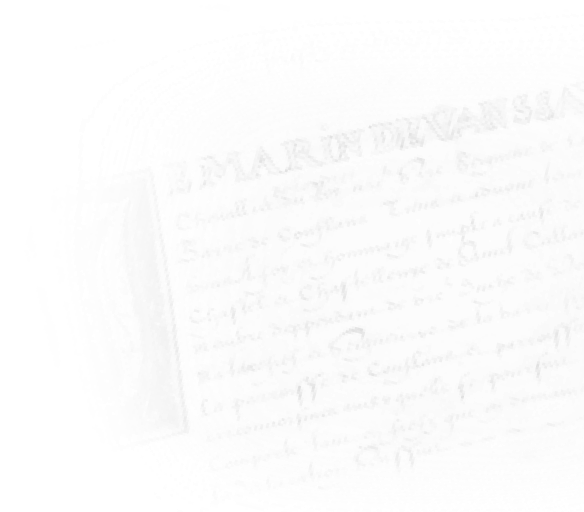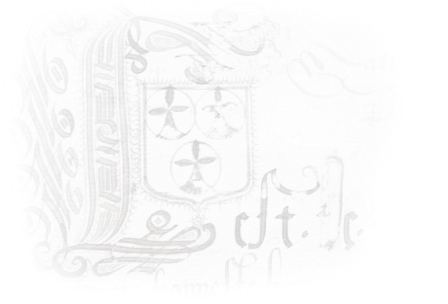

THE de VANSSAY FAMILY, OF IMMEMORIAL NOBILITY, WERE ARMY OFFICERS BY PROFESSION, SERVING FRANCE UNDER THE MONARCHY, THE EMPIRE, AND FINALLY THE REPUBLIC, AS HEROES OF THE RESISTANCE.
The family has maintained their rank over the centuries by keeping its family stronghold, where all the archives are located. It is therefore an exceptional and richly documented example of the development of a family and its castle over seven centuries.
OUR HISTORY
Nominoé, king of the Bretons, invaded Maine and died in Vendôme in 851. Some of his companions settled in the conquered country, notably in Vancé. It was the first place where the Vanssay family lived until the 14th century.
The Vanssay family, of French nobility dating back to medieval times, served their country under the Royalty, under Napoleon and also under the Republic, one of the sons being a well-known hero of the Resistance. The Vanssay family was able to maintain both their rank and the family fiefdom over 7 centuries, thus providing an exceptional example of the evolution of a family and its’ castle. All the archives are housed in the château.
Only one cellar remains of their castle today and the archives of this village were burned during the Revolution. However, in our region there are documents mentioning the Vanssay in 1001, 1037, 1086, 1114, 1150, 1188 and 1200. One of these documents is an act with the Abbey of Saint Calais at the time when William of Saint Calais was the confessor of William the Conqueror. The Vanssays would have had 2 participants, Osberne and Hugo, participating in the reconquest of England and mentioned in the Domesday Book. The Wansey family would be the remaining English branch...
In 1386 Pierre de Vanssay, after having been dispossessed of his seigneury of Vancé, resided at the Seillerie in Conflans sur Anille. We therefore have a precise genealogy of his descendants. His son Jean joined Marie Choué and the Château de la Barre thus joined the Vanssay family, which still owns it. His descendants also settled in Perche and Vendômois, but also in Salins and Vermandois and Lorraine.
With the Wars of Religion, bands of looters raged in the region. Marin de Vanssay had important fortifications built in 1589 with the authorization of the Duke of Mayenne to protect his residence. Allied to Henry IV, this work was maintained by the new king who nevertheless dismantled some of the region’s fortresses, such as Lavardin. Marin de Vanssay will also receive important lands from Henri IV, the Prince of Conti and Biron.
The descendants of Marin de Vanssay were all involved in the military profession. They participated in all the king’s campaigns where they excelled. Thus the family motto: “Virtue (courage) comes before age”, a rare example of a word play in a family motto. In the 17th century, the Renaissance wing on the left was undertaken creating large windows and in 1779 the whole interior remodeled. Finally the fortifications were reduced to a single watchtower. Charles de Vanssay, who had received the honours of the Court, witnessed the culmination of his reformist ideas with the advent of the Revolution. He was chosen as commander of the National Guard of Conflans in 1790.
The Vanssays participated in the Napoleonic campaigns as far as Russia. Then Henry de Vanssay was the private secretary of the Count of Chambord. Alphonse Poitevin, one of the three inventors of photography, tried his hand before 1850 by photographing the Château de la Barre.
A major restoration takes place. New windows and a second staircase tower are created. Many servants lived in the castle and rooms were provided for them.
The men in the family were severely affected by the First World War. The Great Dining Room became a hospital for soldiers wounded on the front lines. The Marquise de Vanssay was estimed and honoured as a nurse. Guy de Vanssay, wounded in the war, is the grand father of the current Count of Vanssay. His father, Pierre de Vanssay was a passionate mechanic and owned a Bollée and a motorcycle.
Upon the death of the Viscount of Vanssay, Guy and Marnie de Vanssay, the present Count & Countess de Vanssay, undertook a complete renovation of the Château, which would take several years, in order to welcome guests appreciative of history and French way of life. After the castle, the garden was replanted. In 2009, the former kitchen cottage was renovated, water and electricity were installed and this part of the 16th century was transformed into elegant cottages. In 2014, the castle’s chapel was restored. In 2018, the son of Guy and Marnie de Vanssay, Viscount Daniel de Vanssay was married at the château, and in 2020, his son Louis, Guy and Marnies' first grandson, was baptised in the family chapel. And in 2021, a large swimming pool was added, in order to be in line with modern times.